👋 Hello and welcome to the 9th edition:
B2B Marketing Playbook for 2024 [Guide]
In this edition, I'm going to share my recommendations on the B2B marketing playbook for 2024. It’s based on my market analysis, experimentation, advisory, and discussions with industry peers.
Please read this guide as an R&D report. As you know, there is no shortcut or hacks to growth and any playbook must be adapted to your business case.
Let’s start;
4 Reasons why you should reinvent your B2B Marketing Playbook
The B2B marketing landscape changed a lot in the past 3 years with a turning point in 2023. This introduction covers the 4 reasons why you should evolve with the market.
Reason 1 - The Rise of the 'Self-Served Buying Journey' Trend
B2B buyers now educate themselves based on content they discover online through various channels, including social media, blogs, podcasts, videos, and online events.
They have developed the ability to search for and find answers independently, thanks to the availability of online tools.
Buyers also have access to online communities, such as LinkedIn groups, WhatsApp groups, Telegram, or Slack groups, where they can receive feedback, share best practices, and gather information from their peers.
The key to success in this context is to create content that guides buyers throughout their journey. Equally important is being easily accessible on any platform at any time.
Reason 2 - Social Media now plays a center role in the decision making process
Gradually, our personal decision-making habits, influenced by social media, have extended to B2B behaviors.
Professionals are using social media more and more for business purposes. Between 2018 and 2022, LinkedIn's user base grew from 580 million to 715 million people. This 23% growth is a good indicator of the increasingly importance of B2B social media.
Professionals are initiating more conversations, connect with more peers, and exchange ideas on social media platforms. These platforms became real business hubs where buyers can launch new projects and start business relationships.
Reason 3 - Paid ads are now very common in B2B
Paid social ads, search ads, and display ads have become standard practices in B2B marketing. When I conduct benchmarks for my clients, I often find that 80% of their competitors are using paid advertising.
Any business that takes digital marketing seriously now uses at least LinkedIn and Google Ads. Moreover, it appears that horizontal SaaS companies like Monday, Grammarly, and Zapier have opened the way for creative video campaigns.
From now on, it's really important to focus on high-quality content. Launching ads that say "book a demo" is not enough anymore. You need to have high-quality content that educates around the problem you solve and also educates about your solution. (more on this in part 2)
Reason 4 - Cold emailing performance is decreasing
Email open rates and reply rates have decreased a lot. In early 2023, generative AI deleted the last entry barrier to cold emailing.
Before that, it was easy to find contact (database tools) and send emails (emailing tools). But now, it’s also easy to ideate a campaign, and write the copy with AI (which I don’t recommend).
The entry barrier to sending emails has never been so low. And it has a strong impact on the results:
More emails (and more spams)
The % open rate decrease
Less results with emailing
This market reality is the foundation of the new marketing playbook that I am about to present. You need to take it into consideration for your business.
So How Should You Adapt?
Here are the 5 basics steps you need to go through:
Accept the market reality (as briefly explained in part 1) and understand the impact on your customers’ buying journey;
Make sure that people who make decisions in your business understand and accept the market reality;
Audit your current marketing playbook to analyze what brings revenue and what doesn’t (you can hire an expert for this part);
Ideate a roadmap to transition to a new playbook that respects the new market reality;
Implement with rapid experimentation, assess repeatability, and build long term marketing programs that respect how your customers buy.
*Don’t try to do 3 and 4 if 1 and 2 are not done.
Now, I'm going to share my point of view on what is the B2B marketing playbook for 2024. Here you can find an infographic that I posted on LinkedIn with 4 different tactics that you should have in your marketing playbook for next year:
This is a non exhaustive playbook as you might need to integrate other actions specific to your business. Make sure to experiment every tactic before drastically changing to a new framework.
The four tactics are:
Content Marketing
Social Selling
Paid Ads
Account-based Outbound
Let’s deep dive into each tactic;
I. Use Content as the Backbone of Your B2B Marketing Strategy
You need to redefine content as a pillar of your marketing strategy because content is what your audience sees but also how they perceive you.
1. Content is the engine’s oil of your revenue system.
It will help you to:
Build awareness for your brand
Create demand for your solution
Position you as an industry authority
Build transparency and trust at scale
Educate about the problem you solve
Close deals by suppressing objections
Move buyers through the buying journey
Here’s an overview of 13 benefits across the whole buying journey:
2. Content Quality is the bare minimum
If your content has poor quality, you will be perceived as a distant noise in the B2B jungle. But if your content gives proper solutions to the problem of your audience, you will be perceived as valuable.
- High quality content that give them solutions? You are valuable.
- Poor quality content that regurgitate basics? You are a distant noise.
Being perceived as valuable = a sum of specific content pieces that always answer your audience’s questions and objections. If your content is always “on point”, your brand will naturally be perceived as “on point”.
3. The 5 rules to publish quality content
“Quality” content can be vague so here is how I define it in 5 rules:
The content is based on audience research (keywords, survey, interviews, desk research) so you are sure that it adresses a real market need, problem, or trend.
You are sharing a unique, or a least a strong point of view through your content that can hardly be found elsewhere.
The insights shared in the content are clear and specific (numbers, proofs, experiments, case studies). The human brain loves clarity and coherence.
The content respects your positioning and messaging (and this needs to be true across all channels)
The copywriting and design are great
4. Volume is also important because your audience needs repetition
Quality is the bare minimum but you also need to publish a lot of content. You should build content programs across channels (e.g. linkedin posts, podcast, content hub, youtube channel) and experiment with a lot of volume to get real results.
People in your industry receive thousands of stimuli everyday. Their brain processes the information and deletes the useless junks. It’s similar as when you clean your inbox and send the spams in the trash.
Repetitive quality content will allow you to become “top of mind” in your audience’s brain. The goal is to build a strong connection between your topic and your brand name.
Hear about the topic → think about your name
Hear about your name → think about the topic
In other words, visibility and compounding effects will come from volume.
I wrote a full free guide on how to build your content strategy so I will let you read it here:
This guide will help you to build your strategy.
II. Social Selling: Sell Directly Within Social Ecosystems
Social selling is a sales strategy that involves using social media platforms and online networks to connect with potential customers (instead of the traditional cold-calling and hard-selling methods).
As explained in the introduction, a lot of B2B buyers are now using social media to meet new industry peers but also to find potential buyers and potential vendors. So it's important to integrate social selling in your strategy.
1. Sell Directy on Social Media
Use social media platforms to connect with potential customers. It involves using social networks such as LinkedIn, X, Facebook, Instagram, and others to identify, engage, and convert leads into customers.
This is very new to most B2B marketers. The good news is that it’s not rocket science.
Here’s a simple 5-step process to do it:
Analyze your audience favorite channels
Post content on this channel(s) (cf my content guide)
Build lists made of target accounts and ICPs
Engage in comments on their posts
Send direct messages to connect (largely underrated)
2. Build Your Own Community
Building a B2B community means making a place online where profesionnals who have similar interests or goals can talk and grow together. The main goal is to host a space where people can help each other. In return, this will help your business. Here’s the difference between an audience and a community:
Audience: one to many (you talk to your audience)
Community: many to many (community members talk to each others)
Building a B2B community is a mix of key 3 elements:
In my opinion, this is one of the hardest tactic of B2B Marketing yet one of the most powerful. With time, you can grow a community that aligns with your brand’s narrative. You will also create a tight audience feedback loop thanks to a direct access to your target audience.
Here are the top 5 channels to make a B2B community:
Slack Channel
Discord
WhatsApp Group
Telegram group
Own channel on Podia
Here’s how you can use a community for social selling (monetization):
Downsell: Prospect is not ready to buy → Invite to your community
Upsell: Audience in your community → Become a paying customer
Private launch: Top member → Early access to new product
3. Rely on the network effects of your team
Your employees' network is a revenue channel. As you know, personal brands are now very important for the C-levels: CEO, CMO, COO, CFO, and so on.
But it's also very useful to leverage the networks of other team members. Everytime you hire a new person, you also integrate this:
Background → what they did before.
Industry network → their connections.
Socials → their profile and followers base.
Expertise → their knowledge and skills.
Personality → who they are as individual.
Those 5 elements constitute their personal brand. If your new employees agree, you can set up a system to help them build their personal brands when they join the company.
It’s a raw diamond that can be leveraged both for the company and the individual:
For the company → Client-acquisition
For the individual → Personal fullfilment and career growth
Here’s how you can use a personal brands for social selling:
Publish content on their Linkedin and X profiles about their expertise.
Create an incentive plan and system to refer clients from their networks.
Give them a safe space to work on a public project (e.g. host workshops 1 Friday per month)
Once again, those actions should come from a mutual agreement between the team members and the company.
III. Rethink your paid ads system
Most B2B Paid ads systems are optimized for unqualified lead generation. A typical funnel is to promote a new ebook, collect emails, send nurturing sequences, and run retargeting ‘book a demo’ campaign.
This playbook is not 100% wrong: if the eBook and sequences are answering a real need, it can be helfpul. But the problem is when the advertising system relies entirely on this funnel. As a result, this happens:
The marketing team hit their KPIs target;
They send thousands of MQLs in the CRM;
But the sales team is drowned in the volume.
This scenario is bad for both teams:
Marketers are not aligned with the business' revenue goals.
Sales are wasting time and resources in leads qualification.
To fix this misalignement, you need to rethink your whole B2B marketing strategy. And one of the key component is to rethink your ads system on 5 points:
1. Stop seeing ads as a magic shortcut for lead generation
The average B2B sales cycle is 4-month long, yet founders expect to get ads ROI in 2 weeks. Shift your expectation to at least a 3-month window for substantial results.
2. Build your ads based on your customer' buying journey
Analyze and map your customers' buying journey. Then, research what they need to read to move to the next buying stage. This is the best way to ideate your ads.
3. Set the north star metric as revenue generation
The marketing and sales team should work towards the same goal (revenue). This will make their collaboration simplier and they will avoid wasting time together.
4. Diversify your ads creatives and experiment new formats
The combo ebook + demo campaign is not enough. Experiment new formats with weekly sprints and track early performance signals. You can also test new channels (e.g. Meta, Tiktok, Google, Youtube, Linkedin, Reddit, X).
5. Connect your ads system to your content strategy
Implement an organic to paid system: test topics and formats with organic content (e.g. linkedin post or youtube shorts). Then promote the best performing content (this reminds me when I was "boosting posts" on Facebook in 2014).
IV. Account-based Outbound Marketing
The entry barrier to sending emails has never been so low. Emailing performance has decreased in the past 6 months with lower open rates and less replies.
Yet, it would be silly to say “outbound is dead”. Because ‘outbound’ means reaching out to your target customers.
Your objective should be to adapt to a new playbook:
1. Rethink the place of outbound
Reposition outbound as a tool within a broader strategy
Use outbound mainly for account based marketing
Research industry deeply before sending ICP-based emails
See every contact as an opportunity, not a data point
Have minimum viable signals to trigger campaigns
Develop an internal intelligence to source real intent
Build a bridge between content and outbound strategies
Integrate social selling within the outbound strategy
And of course all of this should be 100% aligned with GDPR regulation.
2. ABM is the most efficient outbound approach in this playbook because there is a strong link with other tactics.
If you implement tactics (1),(2), and (3) correctly, you’ll have a lot of accounts navigating around your brand:
Content → Demand creation
Community → Active members
Paid ads → More reach to new accounts
You can't rely 100% on demand capture to turn interested audience into revenue pipeline. Some accounts will simply not reach out to you (busy, ego, no trigger, didn't think about reaching out)
3. Put intent signals at the center of your ABM strategy
The objective of ABM here is to capture intent to transform interested accounts into revenue pipeline. In other words, tactics (1),(2), and (3) create “low hanging” fruits that you can contact directly with ABM.
Build an internal system to gather buying intent:
Identify intent signals that matter for your strategy
Install an internal system to find & centralize them
Prioritize accounts based on intent scoring
You can find in the graph enclosed a non-exhaustive list of 30 buying intent signals:
4. Here’s how to implement ABM in 6 steps:
Once you’ve prioritized a list of accounts based on intent, you can follow the following steps for proper ABM:
Research each account individually
Map the decision makers
Craft one strategy per account
Create assets (copy, creatives)
Execute each campaign individually
Analyze and report qualitative learnings
Experiment this Playbook in 2024
That’s my recommendation on the B2B marketing playbook for 2024 in my opinion. I hope it will help you for your strategy. Remember, you need to adapt this playbook to your business’ industry, growth stage, and objectives.
Alright, that’s the end of this 9th edition
B2B Marketing Playbook 2024 (Complete Guide)
Thank you for reading!
If you enjoyed it, feel free to like it and share it with your connections.
👉 If you want to know more or work with me:
Follow me on Twitter for growth and build in public
Follow me on Linkedin for daily marketing tips
Watch my latest video on Youtube
Book a 60-min power-hour call with me for marketing advisory
Contact me directly by email or DM for a 30-day Content Strategy sprint at pierre.herubel@gmail.com





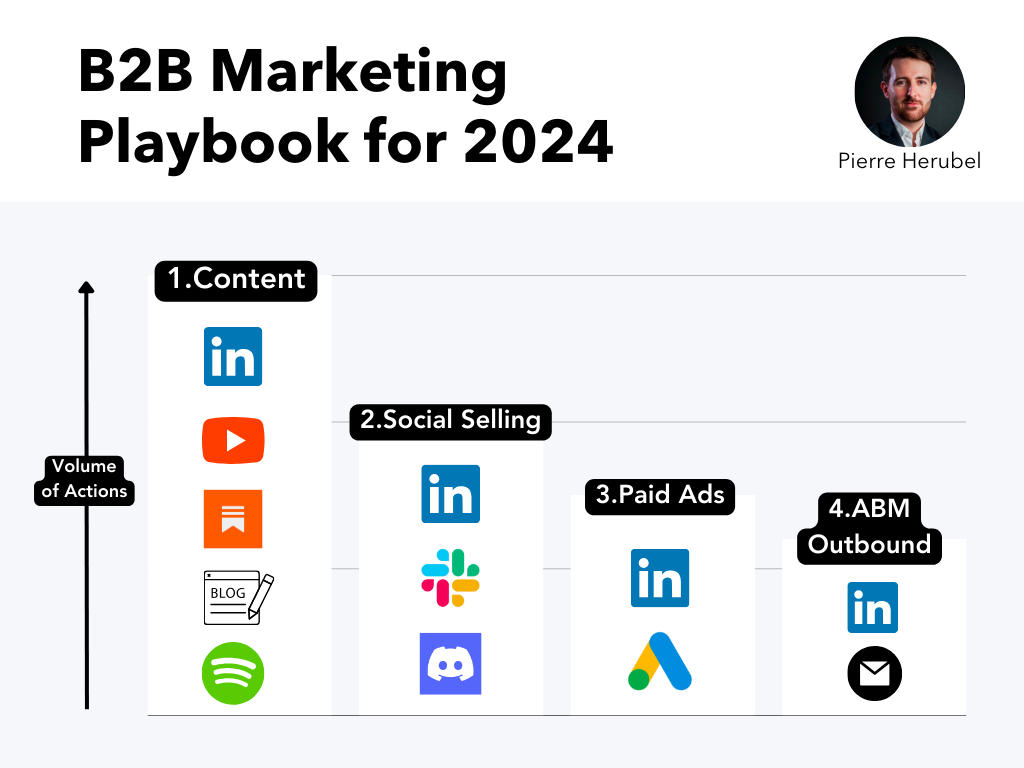

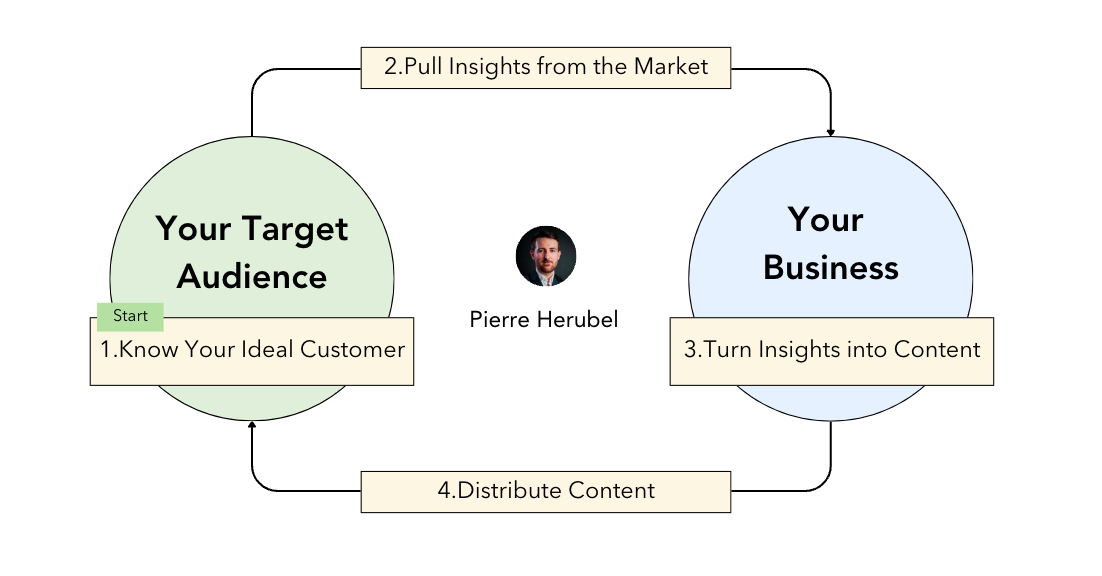
![How to Build Your Content Strategy in 4 Steps [Guide]](https://substackcdn.com/image/fetch/$s_!2kGF!,w_140,h_140,c_fill,f_auto,q_auto:good,fl_progressive:steep,g_auto/https%3A%2F%2Fsubstack-post-media.s3.amazonaws.com%2Fpublic%2Fimages%2F55511378-81df-41a1-bdba-fb437cce934f_360x257.png)


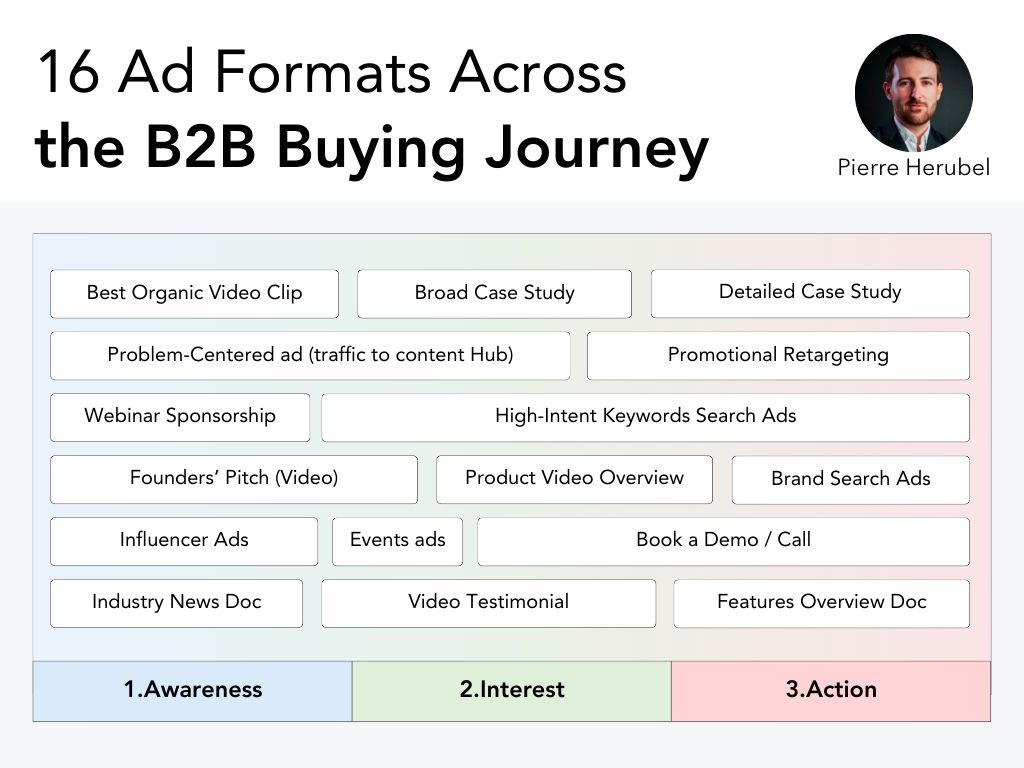

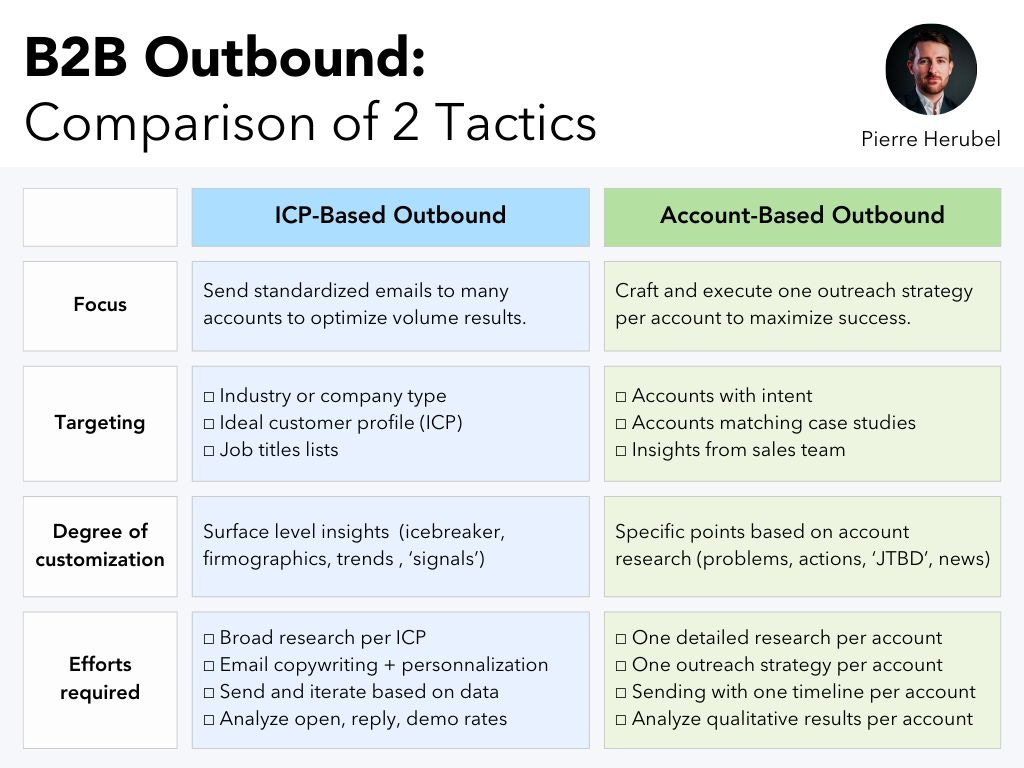
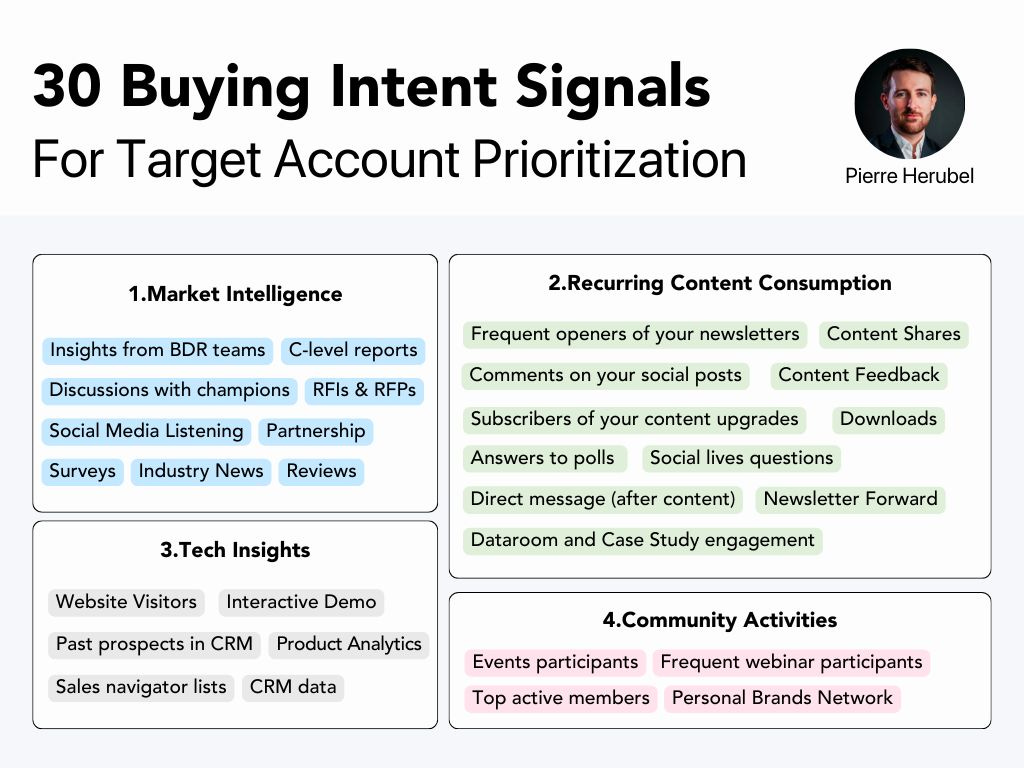
The shift to account based marketing is especially important. I feel like so much of the approach people are using to sell at the B2B level is out of date. The tips here are fantastic. People need to focus more on trust, showing up and being helpful, and being closer to customers rather than trying to achieve everything at immediately to hit internal targets.
"People Over Personas" really struck a chord with its emphasis on human connections. Going beyond static customer profiles and focusing on building genuine relationships recognizes that the heart of any business is people. Diving into the nuances of individual experiences, needs, and preferences allows for a more personalized and resonant approach. This human-centric strategy not only aligns with the current shift towards authenticity in marketing but also acknowledges the unique stories and challenges of each customer.
Now, onto "Content is Conversation." Your perspective on content being a dynamic dialogue is a game-changer. It's not just about broadcasting information; it's about sparking conversations and actively engaging with your audience. This aligns perfectly with the current trend of interactive content, where the audience becomes an integral part of the narrative. By fostering two-way communication, businesses can better understand their audience's evolving needs, preferences, and pain points, leading to more relevant and impactful content.
In essence, these two sections offer a profound shift in mindset – from viewing customers as data points to recognizing them as individuals with distinct stories. And in the world of B2B marketing, where relationships matter, this approach seems like a winning formula for success. Can't wait to see how these strategies reshape the B2B landscape in 2024! 👏